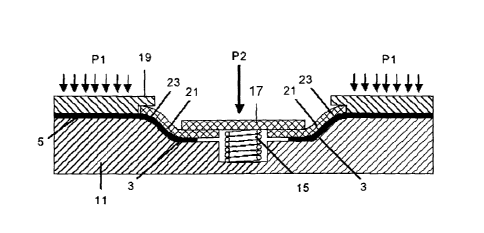Some of the information on this Web page has been provided by external sources. The Government of Canada is not responsible for the accuracy, reliability or currency of the information supplied by external sources. Users wishing to rely upon this information should consult directly with the source of the information. Content provided by external sources is not subject to official languages, privacy and accessibility requirements.
Any discrepancies in the text and image of the Claims and Abstract are due to differing posting times. Text of the Claims and Abstract are posted:
| (12) Patent: | (11) CA 2594206 |
|---|---|
| (54) English Title: | PROCESS FOR MAKING SWAGED LIGHTING HOLES IN PLANAR AREAS OF PREIMPREGNATED COMPOSITE PARTS |
| (54) French Title: | PROCEDE DE FABRICATION DE TROUS D'ECLAIRAGE EMBOUTIS DANS DES ZONES PLANES DE PIECES COMPOSITES PREIMPREGNEES |
| Status: | Deemed expired |
| (51) International Patent Classification (IPC): |
|
|---|---|
| (72) Inventors : |
|
| (73) Owners : |
|
| (71) Applicants : |
|
| (74) Agent: | BERESKIN & PARR LLP/S.E.N.C.R.L.,S.R.L. |
| (74) Associate agent: | |
| (45) Issued: | 2013-09-17 |
| (86) PCT Filing Date: | 2005-12-26 |
| (87) Open to Public Inspection: | 2006-07-06 |
| Examination requested: | 2010-12-21 |
| Availability of licence: | N/A |
| (25) Language of filing: | English |
| Patent Cooperation Treaty (PCT): | Yes |
|---|---|
| (86) PCT Filing Number: | PCT/EP2005/057171 |
| (87) International Publication Number: | WO2006/069989 |
| (85) National Entry: | 2007-06-27 |
| (30) Application Priority Data: | ||||||
|---|---|---|---|---|---|---|
|
The invention relates to a process for making swaged lighting holes (1) in
planar areas of parts (5) made of preimpregnated composite, by means of which
the part (5) is arranged between a female tooling (11) with the final shape of
the bottom side of the swaged part and a caul plate (19) with the final shape
of the top side of the swaged part, except in an area (3) which must be
swaged, pressure P1 is applied on the caul plate (19) in the area of the part
(5) that must be maintained substantially planar, and pressure P2 is applied
by means of a male tooling (17) on the area (3) of the part (5) which must be
swaged at a forward speed allowing the flow of the resin during the slippage
of the fibers of the material so that it may deform, adapting to the final
shape of the female tooling (11).
La présente invention concerne un procédé de fabrication de trous d~éclairage emboutis (1) dans des zones planes de pièces (5) faites de composite préimprégné, selon lequel la pièce (5) est disposée entre un outil femelle (11) avec la forme finale du coté inférieur de la pièce emboutie et un plateau de compression (19) avec la forme finale du côté supérieur de la pièce emboutie, sauf dans la zone (3) qui doit être emboutie, une pression P1 est appliquée sur le plateau de compression (19) dans la zone de la pièce (5) qui doit être conservée sensiblement plane et une pression P2 est appliquée au moyen d~un outil mâle (17) sur la zone (3) de la pièce (5) qui doit être emboutie à une vitesse d~avancement permettant l~écoulement de résine pendant le glissement des fibres du matériau afin qu~elle puisse se déformer, s~adaptant à la forme finale de l~outil femelle (11).
Note: Claims are shown in the official language in which they were submitted.
Note: Descriptions are shown in the official language in which they were submitted.

For a clearer understanding of the status of the application/patent presented on this page, the site Disclaimer , as well as the definitions for Patent , Administrative Status , Maintenance Fee and Payment History should be consulted.
| Title | Date |
|---|---|
| Forecasted Issue Date | 2013-09-17 |
| (86) PCT Filing Date | 2005-12-26 |
| (87) PCT Publication Date | 2006-07-06 |
| (85) National Entry | 2007-06-27 |
| Examination Requested | 2010-12-21 |
| (45) Issued | 2013-09-17 |
| Deemed Expired | 2020-12-29 |
There is no abandonment history.
Note: Records showing the ownership history in alphabetical order.
| Current Owners on Record |
|---|
| AIRBUS OPERATIONS S.L. |
| Past Owners on Record |
|---|
| AIRBUS ESPANA, S.L. |
| CANO CEDIEL, DAVID |
| DURAN QUIROGA, ANTONIO |
| MENENDEZ MARTIN, JOSE MANUEL |
| NOGUEROLES VINES, PEDRO |
| PEREZ PASTOR, AUGUSTO |